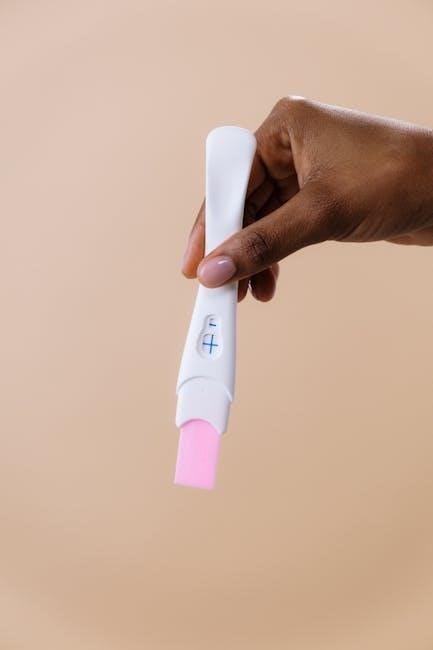cattell iii b test pdf
The Cattell III B Test is a standardized assessment tool designed to evaluate cognitive abilities and aptitudes. Its PDF format offers convenient access for educational and professional applications.
Overview of the Cattell III B Test
The Cattell III B Test is a comprehensive cognitive assessment tool designed to measure a wide range of abilities‚ including verbal reasoning‚ spatial awareness‚ and problem-solving skills. It is widely used in educational and occupational settings to evaluate individuals comprehensively. The test’s structure ensures flexibility‚ making it suitable for varied administration methods. Its popularity lies in its ability to provide reliable and objective insights into an individual’s cognitive potential. The PDF version of the test facilitates easy access and standardization‚ ensuring consistency across administrations. Fair and unbiased‚ the Cattell III B Test is a cornerstone in assessing intellectual capabilities across diverse populations.
Purpose and objectives of the test
The Cattell III B Test is designed to assess a range of cognitive abilities‚ such as verbal‚ spatial‚ and abstract reasoning‚ to evaluate intellectual potential. Its primary objective is to provide a standardized measure of aptitude for academic and professional purposes. The test aims to identify strengths and weaknesses‚ facilitating tailored support for individuals. Its PDF format ensures accessibility and flexibility in administration. By offering a reliable and objective assessment‚ the Cattell III B Test serves as a valuable tool for educational institutions‚ employers‚ and researchers. It plays a role in understanding human cognition and supporting decision-making processes worldwide. The test emphasizes fairness and consistency‚ making it a trusted resource for diverse applications.
Historical background of the Cattell III B Test
The Cattell III B Test has a rich historical foundation‚ rooted in the work of psychologist Raymond Cattell. Initially developed to measure fluid intelligence and cognitive abilities‚ the test has undergone significant revisions to align with modern psychological theories. Over time‚ it has evolved to address diverse cognitive domains‚ ensuring relevance across cultures. The PDF format of the test reflects its widespread use and accessibility‚ making it a cornerstone in psychological assessment. Its historical adaptability highlights its enduring value in understanding human cognition and behavioral patterns.

Structure and Format of the Cattell III B Test
The Cattell III B Test includes sections assessing verbal reasoning‚ non-verbal abilities‚ and cognitive processing; It features problem-solving tasks‚ logic puzzles‚ and standardized scoring. The PDF format ensures flexibility and ease of administration for various applications.
Sections and components of the test
The Cattell III B Test PDF is structured to evaluate a range of cognitive abilities through its key sections. These include verbal reasoning‚ non-verbal reasoning‚ quantitative analysis‚ and visual processing. Each section assesses specific skills‚ such as comprehension‚ problem-solving‚ and logical thinking‚ to provide a comprehensive understanding of an individual’s intellectual capabilities. The test is designed to adapt to different cultural contexts while maintaining its core assessment objectives.
Type of questions and problem-solving tasks
The Cattell III B Test PDF features a variety of question types designed to measure diverse cognitive abilities. These include verbal analogies‚ mathematical problems‚ pattern recognition‚ and spatial reasoning tasks. Problem-solving tasks often involve identifying relationships‚ completing sequences‚ and solving logic puzzles. The test emphasizes critical thinking and adaptability‚ requiring test-takers to analyze information and apply strategies effectively. Each task is carefully crafted to assess specific cognitive functions while maintaining a balance between simplicity and complexity.
Time limits and scoring criteria
The Cattell III B Test PDF typically allows participants 45 minutes to complete the assessment. This includes time restrictions for each section‚ emphasizing efficient problem-solving. Scoring is based on accuracy and creativity‚ with a maximum score of 160. Test-takers must demonstrate both speed and precision. High scorers often gain access to organizations like Mensa. The structured time limits ensure fairness‚ while scoring criteria highlight cognitive strengths. The test’s format and scoring system provide a reliable measure of intellectual potential.

Administering the Cattell III B Test
Administering the Cattell III B Test requires a quiet‚ well-lit environment and specific materials outlined in the PDF. Test-takers must carefully follow instructions to ensure accurate results. Proper preparation and adherence to standardized procedures are essential for valid outcomes.
Conditions for taking the test
Conditions for Taking the Test
To ensure optimal performance‚ the Cattell III B Test requires specific conditions. A、,PDF。Test-takers should remain focused‚ free from distractions‚ and adhere to timing guidelines. Proper preparation‚ including reviewing instructions and practicing sample questions‚ is recommended to maximize performance. These conditions help maintain the integrity and accuracy of the test results.
Materials required for the test
Materials Required for the Test
To take the Cattell III B Test PDF‚ specific materials are essential. A quiet‚ well-lit environment is necessary‚ along with writing utensils or a digital device for recording answers. Test-takers must have a suitable workspace to focus effectively. Additional materials‚ such as scratch paper or an eraser‚ may be needed depending on the test format. Proper preparation and organization of these materials ensure a smooth and accurate testing experience.
Interpretation of results
Interpretation of Results
The interpretation of Cattell III B Test results involves analyzing scores to assess cognitive abilities and aptitudes. Results are compared to established norms to determine an individual’s performance relative to others. High scores may indicate exceptional intellectual potential‚ while lower scores may suggest areas for improvement. The test’s results are commonly used for educational planning‚ career guidance‚ and talent identification. Proper interpretation ensures accurate insights into a test-taker’s strengths and weaknesses.

Popular Uses of the Cattell III B Test
The Cattell III B Test PDF is widely used for educational placement‚ employment testing‚ and psychological research. It assesses cognitive abilities‚ helping to identify potential and guide career choices. Its popularity stems from its reliability and adaptability across diverse settings.
Educational assessments and admissions
The Cattell III B Test PDF is extensively utilized in educational settings to evaluate students’ cognitive abilities and aptitude for academic success. It helps institutions determine eligibility for admission into gifted programs or specialized schools. The test’s structured format ensures objective evaluation‚ providing insights into problem-solving skills and learning potential. For example‚ a 12-year-old boy named Rory Bidwell scored the maximum in the test‚ showcasing its ability to identify exceptional talent. Schools and universities rely on the test to place students appropriately‚ ensuring they receive tailored support. The PDF version allows easy administration and analysis‚ making it a valuable tool for educators and administrators worldwide. By assessing intellectual capabilities‚ the test plays a pivotal role in shaping students’ educational trajectories and fostering fair opportunities for all. Its adaptability across diverse educational systems enhances its effectiveness in various settings‚ from primary schools to higher education institutions.
Occupational aptitude testing
The Cattell III B Test serves as a valuable tool for employers and career counselors to assess individuals’ cognitive abilities relevant to professional roles. By evaluating problem-solving skills and intellectual capabilities‚ it helps determine suitability for specific jobs or industries. For instance‚ a high scorer like Rory Bidwell demonstrates exceptional potential‚ which could translate to career success. Employers use the test to identify candidates with strengths in analytical thinking‚ critical reasoning‚ and adaptability‚ ensuring a better fit for roles that require these skills. The PDF format allows easy administration and analysis‚ making it accessible for organizations to streamline recruitment and career development processes. Overall‚ it helps bridge the gap between talent and opportunity by providing objective insights into professional aptitude. Its adaptability across industries ensures its relevance in diverse occupational settings‚ enhancing its utility for employers worldwide.
Research and academic studies
The Cattell III B Test is widely used in research and academic studies to explore cognitive abilities and their implications across diverse populations. Its PDF format enables researchers to easily administer and analyze the test‚ making it a valuable tool in psychological studies. The test’s standardized design allows for the comparison of results across individuals‚ groups‚ and cultures‚ providing insights into cognitive development and aptitude. Researchers often employ the test to investigate variables like age‚ education‚ and cultural affecting cognitive performance. Its reliability and validity in measuring intelligence make it indispensable for advancing academic and psychological research. The test’s adaptability across different settings further enhances its utility in generating robust and generalized findings.

Benefits of the Cattell III B Test
The Cattell III B Test PDF provides a reliable and standardized method to assess cognitive abilities. Its objectivity ensures fair evaluation‚ while adaptability accommodates diverse settings. Widespread acceptance in education and psychology enhances its practicality. The PDF format facilitates easy access and administration. Its focus on/aptitude makes it a valuable tool for research and professional use.
Objectivity and reliability of the test
The Cattell III B Test‚ introduced in 2017‚ is designed to measure cognitive abilities objectively. Its standardized format ensures fairness‚ as it evaluates individuals under consistent conditions. The test’s reliability lies in its ability to produce consistent results across diverse populations. This ensures unbiased assessment‚ making it a trusted tool in psychological evaluations. Its scoring system is meticulously calibrated to maintain accuracy‚ further enhancing its credibility in academic and professional settings. The test’s historical refinement contributes to its robustness‚ solidifying its reputation as a reliable psychometric instrument. The Cattell III B Test PDF reflects these principles‚ ensuring consistent and valid outcomes.
Widespread acceptance in various fields
Widespread Acceptance in Various Fields
The Cattell III B Test is widely recognized across multiple domains‚ including education‚ employment‚ and psychological research. Its adaptability and proven validity make it a valuable tool for assessing cognitive abilities in diverse settings. Educational institutions and hiring managers rely on its results to identify talent and potential. Additionally‚ its use in academic studies highlights its role in advancing psychological understanding. The test’s accessibility in PDF format further enhances its global adoption. Organizations and professionals trust its reliability‚ cementing its reputation as a cornerstone of psychometric evaluation. Its acceptance underscores its enduring relevance in modern assessment practices.
Accessibility and adaptability
The Cattell III B Test is designed to be accessible and adaptable to a wide range of individuals. Its digital format‚ particularly the PDF version‚ ensures easy distribution and administration in various settings. Whether used in educational‚ professional‚ or research contexts‚ the test accommodates diverse needs. Its adaptability to different languages and cultural contexts further enhances its inclusivity. Additionally‚ its availability in PDF format makes it easy to share and store‚ benefiting both administrators and test-takers alike. This adaptability ensures the test remains relevant and practical for global use.

Limitations and Criticisms of the Cattell III B Test
Despite its widespread use‚ the Cattell III B test faces criticism for potential biases‚ limiting its accuracy. Some argue itsEurocentric standards may not fairly assess diverse populations. Cultural assumptions and rigid scoring criteria have sparked debates about its adaptability and fairness in global assessments.
Potential biases in test design
The Cattell III B Test has faced criticism for potential biases rooted in its design. Critics argue that its Eurocentric framework may not cater to diverse cultural backgrounds‚ potentially disadvantaging individuals from non-Western contexts. Cultural assumptions embedded in test questions can inadvertently favor specific socioeconomic or educational groups. Additionally‚ the focus on certain cognitive abilities over others has raised concerns about its inclusivity. Efforts to address these biases through cultural adaptions are ongoing.
Controversies surrounding test validity
The validity of the Cattell III B Test has sparked significant debate. Critics question whether the test accurately measures innate intelligence or merely reflects cultural and socioeconomic factors. Some argue that its content may favor certain groups‚ undermining its claimed objectivity. Others point to variability in test outcomes across different populations‚ raising concerns about its universal applicability. Despite these‚ supporters maintain that the test remains a valuable tool for assessing cognitive abilities. Nevertheless‚ its limitations and external factors continue to fuel discussions about its fairness and effectiveness.
Alternatives to the Cattell III B Test
Various alternatives to the Cattell III B Test exist‚ catering to different assessment needs. The Stanford-Binet and Wechsler Adult Intelligence Scale (WAIS) are popular IQ tests offering comprehensive cognitive evaluations. These tests often include broader metrics‚ such as verbal‚ nonverbal‚ and working memory assessments‚ providing deeper insights than the Cattell. Additionally‚ the Reynolds Intellectua

Common Questions About the Cattell III B Test
Is the Cattell III B Test accurate? Can it be cheated? How often is it updated? Explore these questions to better understand the reliability and integrity of the test PDF‚ ensuring informed decision-making.
Discover answers to frequently asked questions about the Cattell III B Test‚ including its accuracy‚ the possibility of cheating‚ and how it keeps pace with evolving standards. These insights clarify the test’s purpose and practical use.
Learn about the Cattell III B Test’s reliability‚ fairness‚ and adaptability. This section addresses concerns about accuracy‚ cheating‚ and updates‚ helping users make informed decisions about its use.
Explore the Cattell III B Test’s credibility and effectiveness. Find answers to common queries about its accuracy‚ potential for manipulation‚ and regular updates‚ ensuring transparency in its application.
Understand the Cattell III B Test’s strengths and limitations through key questions. Learn about its accuracy‚ susceptibility to cheating‚ and frequency of revisions to assess its suitability for various purposes.
Is the test accurate?
The accuracy of the Cattell III B Test is a frequent concern. Designed to measure cognitive abilities‚ it employs standardized questions to ensure reliability. However‚ accuracy may vary depending on cultural biases‚ language barriers‚ or prior educational exposure. Validity studies confirm its ability to predict academic and occupational performance‚ though disputes arise over its generalizability across diverse populations. The test remains widely used‚ with continuous updates to mitigate weaknesses and enhance fairness. Its effectiveness in real-world applications‚ such as Rory Bidwell’s maximum score‚ highlights its ability to identify high cognitive potential. Nonetheless‚ ethical considerations and test-taker preparation significantly influence outcomes‚ emphasizing the importance of proper administration.
Can the test be cheated?
Cheating on the Cattell III B Test is challenging due to its standardized design and strict administration protocols. The test includes a variety of question types and time limits‚ making it difficult to guess patterns or memorize answers. Additionally‚ proctors monitor test-takers to prevent unauthorized assistance. While some may attempt strategies like pacing or selective guessing‚ these rarely lead to accurate results. The test is designed to assess genuine cognitive abilities‚ ensuring fairness and reliability. However‚ dishonest practices‚ such as accessing prior questions or sharing answers‚ remain potential risks if proper security measures are not enforced. Always prioritize integrity to obtain accurate and meaningful results.ряд
How often is the test updated?
The Cattell III B Test undergoes periodic updates to ensure relevance and accuracy. Typically‚ revisions occur every 5 to 10 years‚ reflecting advancements in psychological research and test administration practices. Updates aim to refine question content‚ scoring methods‚ and administration guidelines to better align with current cognitive assessment standards. These modifications are carefully reviewed to maintain the test’s fairness and reliability. Users can access the most recent version of the Cattell III B Test PDF through official channels to stay informed about any changes. Ensuring the test remains valid and representative of contemporary cognitive assessments is a priority for its developers and administrators. This cyclical process of evaluation and refinement helps maintain the test’s credibility and effectiveness over time.язык

Historical Evolution of the Cattell III B Test
The Cattell III B Test evolved through testing methodologies‚ refining its approach to cognitive assessment. It reflects advancements in psychological research and the need for cultural adaptability‚ ensuringIts historical progression underscores its enduring relevance and reputation as a reliable cognitive evaluation tool.
Development and refinement of the test
Development and Refinement of the Test
The Cattell III B Test was developed through rigorous evaluation and refinement to measure diverse cognitive abilities. Over the years‚ updates aimed to enhance its reliability and validity‚ ensuring it remains aligned with modern psychological theories and testing standards.
Its design reflects an iterative process‚ incorporating feedback and empirical data to improve fairness and accessibility. Continuous updates ensure the test adapts to evolving educational and professional demands‚ maintaining its relevance in assessing human potential.
Influence of psychological theories
Influence of Psychological Theories
The Cattell III B Test draws from influential psychological theories to assess cognitive abilities comprehensively. It incorporates theories of intelligence‚ personality‚ and learning‚ providing a holistic understanding of individual potential. The test’s design reflects the work of psychologists who emphasized the importance of measuring diverse cognitive traits‚ ensuring its relevance across cultures and contexts. Its adaptability aligns with evolving psychological frameworks‚ making it a robust tool for evaluating human capabilities. Psychological research has shaped its questions and dimensions‚ ensuring its alignment with modern testing standards.
Adaptations for different cultures
Adaptations for Different Cultures
The Cattell III B Test has been adapted for use across diverse cultural contexts to ensure fairness and relevance. These adaptations involve linguistic adjustments‚ cultural references‚ and test norms to accommodate different demographics. Standardization processes ensure the test remains valid and reliable in various settings‚ making it accessible for individuals worldwide. This approach addresses potential biases and enhances its applicability in multicultural environments.

Comparing the Cattell III B Test to Other IQ Tests
The Cattell III B Test stands out for its focus on assessing reasoning and problem-solving skills. Unlike some other IQ tests‚ it emphasizes practical applications‚ making it widely used in educational and occupational settings. Its adaptability across cultures enhances its comparative value in diverse environments.
Similarities and differences with other tests
Like other IQ tests‚ the Cattell III B Test focuses on assessing cognitive abilities and problem-solving skills. Unlike many tests‚ however‚ it emphasizes practical applications and real-world scenarios. The test evaluates logical reasoning‚ spatial awareness‚ and abstract thinking‚ making it distinct from other assessments. Its PDF format ensures consistency and adaptability‚ aligning it with modern testing standards while maintaining its focus on comprehensive cognitive evaluation.
Strengths and weaknesses compared to competitors
The Cattell III B Test PDF stands out for its standardized format‚ ensuring reliable and consistent results across users. Its focus on practical applications and real-world problem-solving tasks makes it a strong tool for assessing cognitive abilities. However‚ some competitors offer more interactive or adaptive features‚ making them potentially more engaging. Additionally‚ the PDF format can limit its accessibility for individuals without proper printing or digital tools. While widely accepted‚ the Cattell III B Test may not cover as broad a range of cognitive domains as some modern alternatives.
Which test is more popular?
The Cattell III B Test is widely recognized for its use in assessing cognitive abilities‚ particularly in educational and psychological contexts. However‚ its popularity varies compared to other IQ tests. Competitors like the Stanford-Binet and Wechsler Adult Intelligence Scale (WAIS-IV) are often considered more comprehensive and widely adopted. These alternatives incorporate modern psychometric techniques and are frequently used in clinical and research settings. The Cattell III B Test remains a respected tool‚ but its niche focus on specific cognitive domains makes it slightly less popular for broader applications. Its popularity depends on the intended purpose and target audience.

Publishing and Availability of the Cattell III B Test PDF
The Cattell III B Test PDF is available through official channels and authorized publishers. Ensuring access to verified sources is crucial for accuracy and reliability.Updates are periodically released to maintain relevance and adapt to evolving standards.
Where to find the Cattell III B Test PDF
The Cattell III B Test PDF can be accessed through official publishers and authorized sources. Educational institutions and psychological professionals often utilize the test. Additionally,online platforms provide verified copies for academic and research purposes. Users should seek reputable providers to ensure authenticity and reliability.
Official vs. unofficial versions
Official vs. Unofficial Versions
Official versions of the Cattell III B Test PDF are developed and distributed by authorized publishers‚ ensuring standardized administration and reliability. Unofficial versions may lack proper validation or may be modified‚ leading to potential inaccuracies. Users should verify sources to ensure they are accessing legitimate materials. Only official versions guarantee the integrity and credibility of the test results‚ confirming their suitability for professional or academic use.
Updates and revisions to the PDF
Updates and Revisions to the PDF
The Cattell III B Test PDF undergoes periodic updates and revisions to ensure its relevance and accuracy. These updates may include modifications to question formats‚ scoring criteria‚ or content to reflect contemporary standards. Test developers collaborate with experts to maintain the tool’s effectiveness while addressing feedback and incorporating new research findings. Users should verify the PDF’s version number to ensure they have the most current‚ validated materials for reliable and fair assessments.
The Cattell III B Test has proven itself as a reliable and widely accepted cognitive assessment tool‚ thanks to its structured format and scientific foundation. Its PDF version ensures accessibility and convenience for various applications‚ from educational to occupational settings. Despite criticisms of biases and validity concerns‚ the test remains popular due to its adaptability and objectivity. As a standardized tool‚ it continues to play a vital role in evaluating cognitive abilities‚ though ongoing improvements are essential to address potential limitations and ensure fairness for all users.


